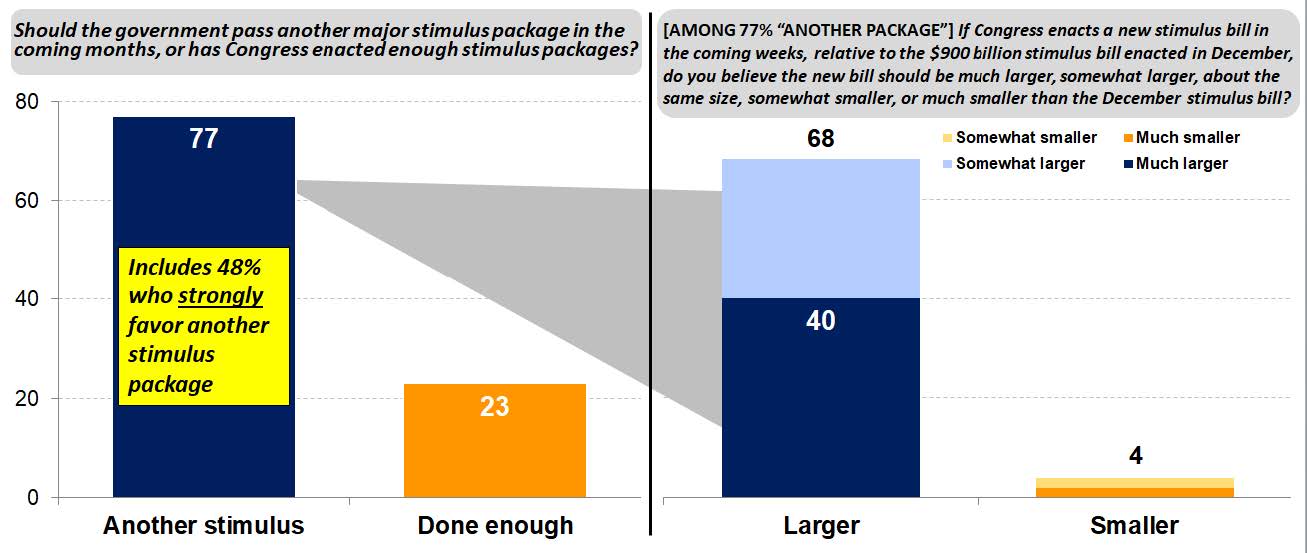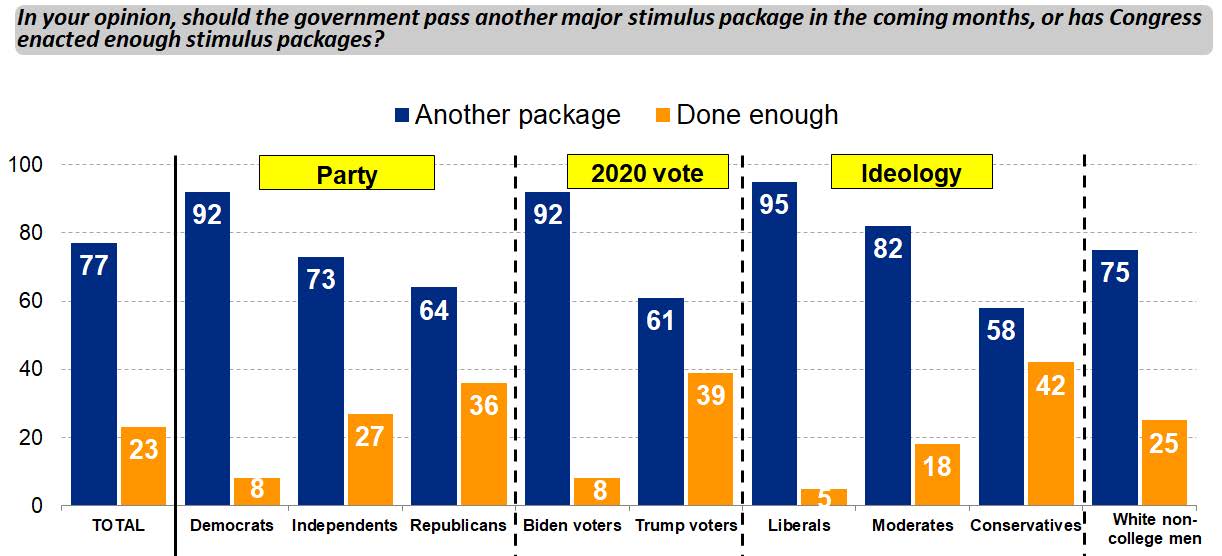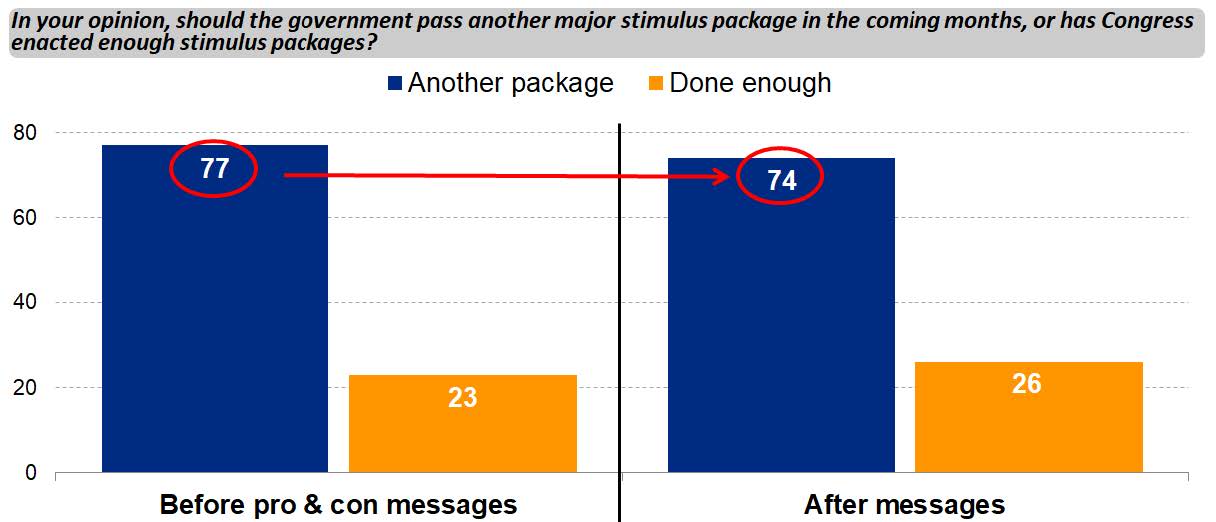A new nationwide survey by GQR, conducted for ‘Invest in America Action’, finds overwhelming support for another major stimulus package, as President Joe Biden pushes Congress to approve his $1.9 trillion COVID-relief plan.
The GQR survey, fielded January 14-18, finds that public support is broad, bi-partisan, and stubborn. By a lopsided 77-23% margin of registered voters, the public supports a major new stimulus package; this includes 92% of self-identified Democrats, 73% of Independents, and 64% of Republicans.
Moreover, even after hearing an extended and balanced debate about COVID relief versus deficits, support barely changes, with 74% by the end of the survey still supporting a major new stimulus package.
Read the full memo on the survey below.
There is overwhelming public support for another sweeping stimulus package to help the country rebound from the health and economic crisis caused by COVID-19. A new survey finds that a lopsided, bipartisan majority – over three quarters of all registered voters – want another major stimulus package, and that most of those want it to be bigger than last December’s stimulus bill.[1]
The desire for a major new spending package is notably broad: strong majorities of both Biden and Trump voters, both Democrats and Republicans, both liberals and conservatives, all support it. The support is also fiercely stubborn: even after hearing a balanced debate on this question, including strong arguments about the perils of deficits and debt, support for another stimulus package barely moves.
Americans Unified Around Need for a New Stimulus Package
At a time of historic national divisions, Americans are notably unified around this idea: the country badly needs a new and larger stimulus package to relieve the health and economic suffering caused by COVID-19. By a huge 77-23% margin, registered voters say the government should “pass another major stimulus package in the coming months,” and reject the idea that “Congress has enacted enough stimulus packages.” Most of those who support another package – 48% out of the total 77% – feel this way strongly.
Moreover, as Figure 1 shows, by a lopsided 68-4% margin, most of those calling for a new stimulus package want it to be larger rather than smaller than December’s $900 billion effort (28% say it should be about the same size). This desire for a larger package reflects a strong sense that the two past stimulus packages were insufficient. Although the first two stimulus packages from 2020 are popular, a 54-13% majority believes they provided “too little” rather than “too much” assistance (34% say the amount of assistance in those bills was “about right”).
Figure 1: Support for “another major stimulus package” and preference on size of the package

The need for another sweeping stimulus package emerges as a rare point of bipartisan agreement. It wins support not only from nearly all Democrats (92%), but also the vast majority of Independents (73%) and a solid majority of Republicans (64%). It has strong majority support from both Biden voters (92%) and Trump voters (61%). While self-identified liberals are most enthusiastic (95%), the idea also gets majority support from moderates (82%) and conservatives (58%).
As Figure 2 shows, among one of the most pro-Trump demographic groups, white men without a college education, support for another major stimulus package is overwhelming – 75%.
Figure 2: Support for “another major stimulus package” across selected groups

Voters feel a sense of urgency in confronting what many see as a national “emergency,” with less concern about the immediate implications for the nation’s deficits and debt. As a male Independent voter says in one of the focus groups, “When your house is on fire, you don’t worry about how much the fire department is going to charge you.” Another participant talks about a focus on the deficit at this point as “penny wise, pound foolish.”
Support for a Major New Stimulus Package is Stubborn
Support remains strong even after voters hear arguments against a new stimulus package, and then listen to an extensive and balanced debate about it.
As Figure 3 shows, after listening to a battery of elaborated arguments in favor of a new stimulus bill, and a battery against (respondents are randomized in terms which they hear first), support for a major new stimulus bill dips by only 3 points, to a 74-26% majority.
Figure 3: Support for a major new stimulus package, before and after hearing pro & con arguments

Health and Economic Impact of COVID-19 Drives Support for New Spending
The research underscores that the main driver of support for a major new spending initiative is the pandemic. Americans believe COVID-19 has created both a health emergency and an economic emergency, which only a major new stimulus package can relieve.
As a Democratic woman says in the focus groups regarding the effort to combat the coronavirus: “it’s the most important thing; we have so many people losing their lives to COVID…we need to get it under control before we think of anything else.” One of the Independent men in the other focus group highlights the economic dimension of combatting the virus: “It’s the lynchpin for everything, you get kids back in school, single parents can get back to work, so many things feed off of that, it has to be the first thing.”
Out of a list of 10 major potential areas of new spending, the two that by far command the most support are “investing in public health and ways to get the COVID vaccine to everyone more quickly” (71% select it as one of their top two preferences); and “sending $2,000 stimulus checks directly to households” (64% select it as one their top two priorities). None of the other items on the list gets over 50% selecting it as one of their top two priorities.
The dominant support for COVID-19 relief underscores the immense opportunity to define a new stimulus bill tightly around that idea. It also suggests support for new spending on other national priorities may be stronger if it is connected explicitly to the fight against the pandemic and the resulting economic fallout.
Core Message: America Uniting in the Face of an Emergency
The research points to a simple message frame: the idea that Americans must come together in the face of this new COVID-driven emergency. Out of 13 messages in favor of a new stimulus package, this one produces the strongest result, with 84% percent agreeing (significantly higher than the 77% who initially say they favor another major stimulus package), including 48% who agree strongly:

This message strikes a chord across most lines that divide Americans today; it draws agreement from:
- 89% of Democrats
- 82% of Independents
- 81% of Republicans
- 79% of Trump voters
- 84% of white non-college-educated men
The idea of “coming together” has great appeal against the backdrop of the country’s deep partisan divisions. The proof points around small businesses, joblessness, and food lines emerge as memorable. Just invoking the idea of the current “emergency” is enough to connect all this to COVID-19.
[1] This memo is based on research designed and conducted by GQR and sponsored by Invest in America Action. The research included two virtual focus groups, conducted January 5 and 6, 2021, with two different segments of swing voters: a group of older white men who were self-identified political Independents; and a multi-racial group of younger women who were soft Democrats. The quantitative conclusions in this memo flow from a nationwide, representative online survey of 1,000 registered voters, conducted January 14-18, 2021.
